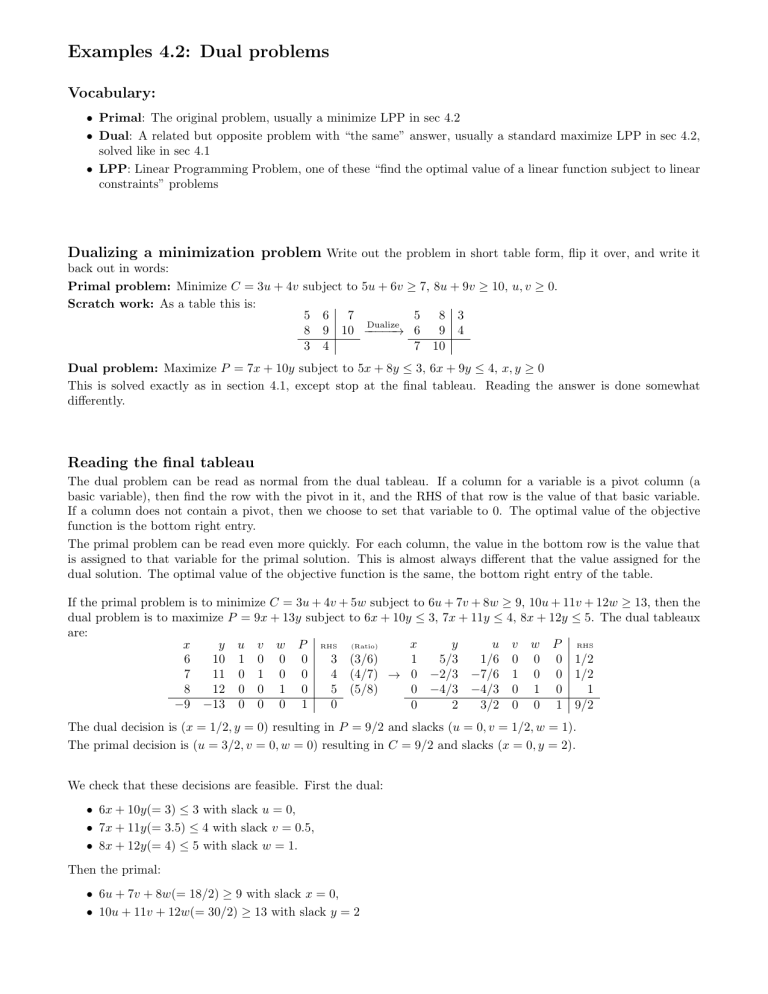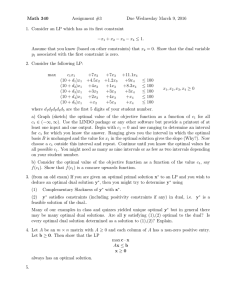
Examples 4.2: Dual problems Vocabulary: • Primal: The original problem, usually a minimize LPP in sec 4.2 • Dual: A related but opposite problem with “the same” answer, usually a standard maximize LPP in sec 4.2, solved like in sec 4.1 • LPP: Linear Programming Problem, one of these “find the optimal value of a linear function subject to linear constraints” problems Dualizing a minimization problem Write out the problem in short table form, flip it over, and write it back out in words: Primal problem: Minimize C = 3u + 4v subject to 5u + 6v ≥ 7, 8u + 9v ≥ 10, u, v ≥ 0. Scratch work: As a table this is: 5 6 7 5 8 3 Dualize 8 9 10 −−−−−→ 6 9 4 3 4 7 10 Dual problem: Maximize P = 7x + 10y subject to 5x + 8y ≤ 3, 6x + 9y ≤ 4, x, y ≥ 0 This is solved exactly as in section 4.1, except stop at the final tableau. Reading the answer is done somewhat differently. Reading the final tableau The dual problem can be read as normal from the dual tableau. If a column for a variable is a pivot column (a basic variable), then find the row with the pivot in it, and the RHS of that row is the value of that basic variable. If a column does not contain a pivot, then we choose to set that variable to 0. The optimal value of the objective function is the bottom right entry. The primal problem can be read even more quickly. For each column, the value in the bottom row is the value that is assigned to that variable for the primal solution. This is almost always different that the value assigned for the dual solution. The optimal value of the objective function is the same, the bottom right entry of the table. If the primal problem is to minimize C = 3u + 4v + 5w subject to 6u + 7v + 8w ≥ 9, 10u + 11v + 12w ≥ 13, then the dual problem is to maximize P = 9x + 13y subject to 6x + 10y ≤ 3, 7x + 11y ≤ 4, 8x + 12y ≤ 5. The dual tableaux are: x y u v w P RHS x y u v w P RHS (Ratio) 1 5/3 1/6 0 0 0 1/2 3 (3/6) 6 10 1 0 0 0 7 11 0 1 0 0 4 (4/7) → 0 −2/3 −7/6 1 0 0 1/2 0 −4/3 −4/3 0 1 0 1 8 12 0 0 1 0 5 (5/8) −9 −13 0 0 0 1 0 0 2 3/2 0 0 1 9/2 The dual decision is (x = 1/2, y = 0) resulting in P = 9/2 and slacks (u = 0, v = 1/2, w = 1). The primal decision is (u = 3/2, v = 0, w = 0) resulting in C = 9/2 and slacks (x = 0, y = 2). We check that these decisions are feasible. First the dual: • 6x + 10y(= 3) ≤ 3 with slack u = 0, • 7x + 11y(= 3.5) ≤ 4 with slack v = 0.5, • 8x + 12y(= 4) ≤ 5 with slack w = 1. Then the primal: • 6u + 7v + 8w(= 18/2) ≥ 9 with slack x = 0, • 10u + 11v + 12w(= 30/2) ≥ 13 with slack y = 2 MA162 Section: Date: 2010-03-02 Name: Quiz on 4.2: Dual problems Setup the dual table: Minimize C = 3u + 4v subject to u + v ≥ 5, 2u + v ≥ 6, u ≥ 0, v ≥ 0 Hint: Dual problem is maximize P = 5x + 6y subject to x + 2y ≤ 3, x + y ≤ 4, x ≥ 0, y ≥ 0 x y u v P RHS (Ratio) Do one complete pivot step (step 2): Be sure to circle the pivot column, find the ratios, and circle the pivot row in the table above. x R y u R −−−−−−−−−→ Read the primal answer from the dual table: Decision: (u = ,v = ) Result: C = Slack: (x = ,y = ) Dual decision is (x = 3, y = 0) with result P = 15 and slacks (u = 0, v = 1) v P RHS MA162 Section: Date: 2010-03-02 Name: Activity 4.2a: Setting up the table 1. Write down the dual table associated to the linear programming problem: Minimize C = 3u + 4v subject to u + v ≥ 4, 2u + v ≥ 5, u ≥ 0, v ≥ 0. x y u 2. Write down the linear programming problem associated and u, v are the primal variables): x y u 5 6 1 9 7 0 −4 −8 0 Minimize: v P RHS to the dual table (assume that x, y are the dual variables v 0 1 0 P 0 0 1 RHS 20 25 0 subject to . 3. Write down the table associated to the linear programming problem: Minimize C = 3u + 4v + 5w subject to u + v ≥ 4, v + w ≥ 5, u ≥ 0, v ≥ 0, w ≥ 0. x y u v w P RHS 4. Write down the linear programming problem associated to the dual table: x 5 9 10 −4 Minimize: y u v 6 1 0 7 0 1 11 0 0 0 −8 0 subject to w 0 0 1 0 P 0 0 0 1 RHS 20 25 35 0 . Activity 4.2b: Reading the answer 1. Read the answer for the primal problem from this final tableau for the dual problem (assume u, v, w were the primal variables and x, y the dual): x y u v w P RHS 0 1 4 5 0 0 10 1 0 6 7 0 0 11 0 0 8 9 1 0 12 0 0 13 14 0 1 15 Primal: The minimum is C = occurring at (u = ,v = ,w = ). Dual: The maximum is P = 15 occurring at (x = 11, y = 10) with slack variables (u = 0, v = 0, w = 12) 2. Read the answer for the primal problem from this dual tableau: x y 0 2 1 6 0 10 Primal: The minimum is C = z 1 0 0 u 3 7 11 v P RHS 4 0 5 8 0 9 0 1 12 occurring at (u = ,v = ). Dual: The maximum is P = 12 occurring at (x = 9, y = 0, z = 5) with slacks (u = 0, v = 0) 3. In this problem, I’m only asking you to read the answer from the table. I’ll work out the first part: Question: Find the minimum of C = 3u + 4v subject to u + v ≥ 4, 2u + v ≥ 5, u + 3v ≥ 6, u ≥ 0, v ≥ 0. Solution: The dual problem is: maximize P = 4x + 5y + 6z subject to x + 2y + z ≤ 3, x + y + 3z ≤ 4, x ≥ 0, y ≥ 0. x 1 1 −4 y 2 1 −5 z 1 3 −6 u 1 0 0 v 0 1 0 P 0 0 1 RHS 3 4 0 (Ratio) (3) (4) → − x 1 0 0 y 2 −1 3 z 1 2 −2 u 1 −1 4 v 0 1 0 P 0 0 1 RHS 3 1 12 (Ratio) (3) (1/2) → x 1 0 0 y 5/2 −1/2 2 z 0 1 0 u 3/2 −1/2 3 v −1/2 1/2 1 P 0 0 1 RHS 5/2 1/2 13 From the final tableau for the dual problem, read the primal solution: Primal: The minimum is C = occurring at (u = ,v = ). Dual: The maximum is P = 13 occurring at (x = 5/2, y = 0, z = 1/2) with slacks (u = 0, v = 0). You should check using the method of corners that this is correct. At the very least check that your answer is feasible (satisfies the constraints) and cannot be easily improved (say, by adding 1 to one of the variables).





